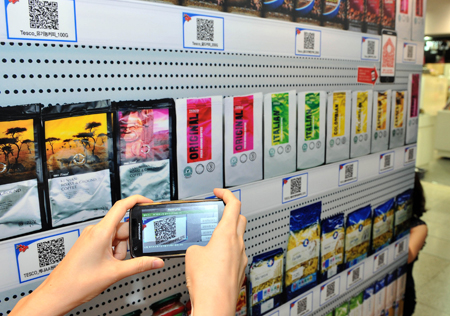Smartphones reshape retail landscape

A woman uses her smartphone to examine coffee products at a virtual “smart” store operated by Home plus at Seolleung Subway Station in southern Seoul. The next-generation branch, which has the photos of the products but not the real items, allows customers to use cameras and bar code-reading applications on their handsets to browse and purchase goods, which are delivered to their homes. (Photo : The Korea Times/Lee Ho-jae)
The growing use of smartphones has entirely changed lifestyles in the 21st century, expanding to online shopping and changing the landscape of the retail industry.
According to data from the Korea Online Shopping Association (KOLSA), monetary transactions via mobile online shopping totaled 3 billion won in 2009 when there were only 750,000 smartphones users at the time.
But the numbers have surged since then: in 2010, transactions amounted to 14 billion won from 7.18 million users. Last year, the “market” grew to 200 billion won with 22.8 million people using the devices.
This year, KOLSA expects 34.8 million Koreans will be using smartphones and shop via the device with the amount of monetary transactions exceeding 600 billion won.
The report also states that the online shopping market grew 17 percent last year and will increase by 13 percent this year. The organization said Korea’s overall online shopping market was valued at 39.4 trillion won in 2011, and expects new revenue pipelines for firms via the new mobile platform.
The Korea Communications Commission (KCC), the nation’s telecom regulator, has released similar data in which they surveyed 4,000 smartphones users and asked how many of them used the device to shop online. The survey showed 47 percent did, nearly triple the 16.9 percent from a same survey conducted in July last year by the agency.
As touch-screen devices allow users to shop anywhere at any place, online shopping businesses are seeing rising profits that reflect the trend.
SK Planet’s online shopping affiliate 11st announced Friday that it has marked 100 billion won worth of shopping through its mobile platform in the first half of the year. The number is higher than last year’s total of 80 billion won, proving that the market is indeed growing. According to SK Planet representatives, last month alone the company saw subscribers spend 20 billion won and it expects to see 150 billion for the year easily.
“Open Market, Home Shopping and other online shopping malls are introducing new user interface apps that allow shopping via smartphones,” said an SK Planet official. “People are buying mostly household utensils and daily products.”
The official said just like online shopping became the next best thing over visiting department stores, mobile online shopping will be the dominant shopping method for consumers.
“More products are becoming available on mobile shopping platforms, with the selections nearly equaling that of their online counterparts. Companies are strengthening services to meet the new demand.”
Women in their 20s and 30s, especially working moms, seemed to be the dominant consumer base as they have the least amount of time between taking care of their children and their jobs, the official added.
Lotte.com is also reaping the benefit of the new market hitting 5.3 billion won in May, a 40-fold increase from a year ago. The company says transaction values are increasing by a monthly 20 percent.
Home Plus offers a delivery service for users taking pictures of QR Codes of products using smartphone cameras and sending them to the company requesting delivery. GS Shop says the rising market is the next growth engine for the firm amid stalling growth in distribution.
John & Green, a community mall that sells eco-friendly goods, has opened a mobile home page to sell its product via mobile platforms. <The Korea Times/Cho Mu-hyun>























































Pingback: Is the coffee sector ready for the top ten global trends? Part II « Cafe Pasion